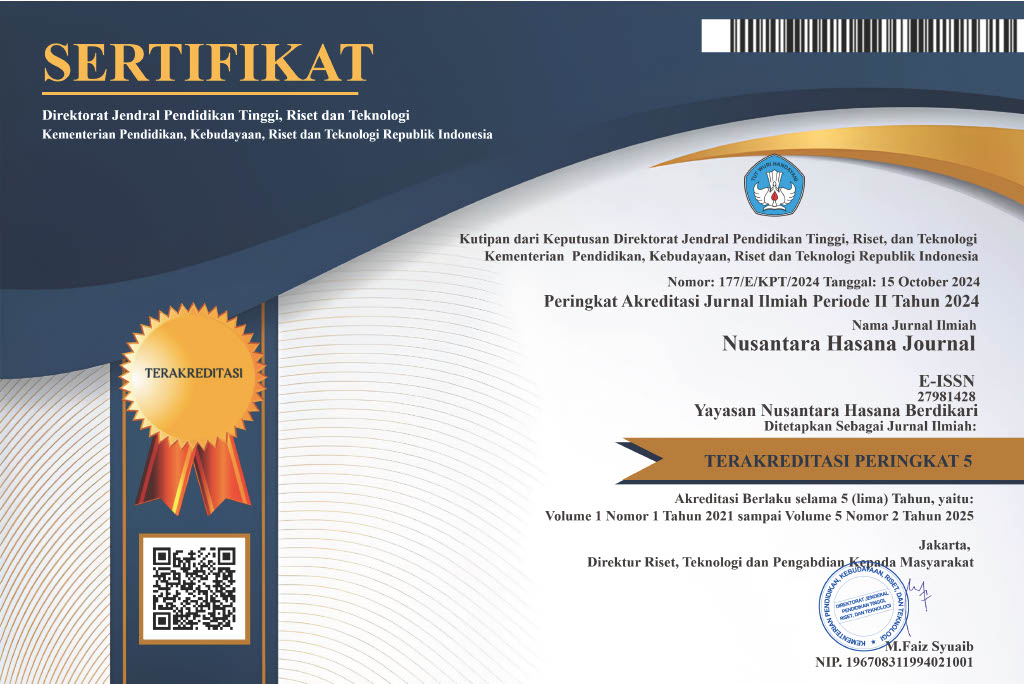CURCUMA XANTHORRHIZA ROXB. IN DIGESTIVE HEALTH MANAGEMENT: A SYSTEMATIC REVIEW OF PHARMACOLOGICAL AND ETHNOMEDICAL EVIDENCE
DOI:
https://doi.org/10.59003/nhj.v4i12.1442Keywords:
Curcuma xanthorrhiza, digestive disorders, traditional medicine, curcuminoid, xanthorrhizolAbstract
Curcuma xanthorrhiza Roxb. (commonly known as Temulawak) is a traditional Indonesian medicinal plant widely used for managing digestive disorders. This systematic review aims to critically evaluate the pharmacological mechanisms, clinical relevance, and ethnomedicinal applications of Curcuma xanthorrhiza in digestive health. Literature was obtained from PubMed, ScienceDirect, Scopus, Google Scholar, and Garuda from 2013 to 2023, using keywords including "Curcuma xanthorrhiza," "digestive health," "gastrointestinal disorders," "curcuminoids," and "xanthorrhizol." The included studies reveal that bioactive compounds such as curcuminoids (1.6%–2.2%) and xanthorrhizol (1.48%–1.63%) exert hepatoprotective, anti-inflammatory, antimicrobial, and carminative effects. Traditional forms include fresh herbal decoctions, powdered simplisia, and polyherbal formulas, while modern preparations involve standardized extracts. Curcuma xanthorrhiza demonstrates promising efficacy and safety for improving digestive function and modulating gastrointestinal metabolism. Its integration into clinical phytotherapy and public health strategies could provide a culturally relevant, evidence-based alternative to conventional therapy.
Downloads
References
Quigley EM. Gut microbiota and the role of probiotics in therapy. Curr Opin Pharmacol. 2011; 11 (6): 593–603.
Chiba M, Nakane K, Komatsu M. Westernized diet is the most ubiquitous environmental factor in inflammatory bowel disease. Perm J. 2019; 23: 18–107.
Lacy BE, Weiser K, Noddin L, et al. Irritable bowel syndrome: patients’ attitudes, concerns and level of knowledge. Aliment Pharmacol Ther. 2007; 25 (11): 1329-1341.
Ekor M. The growing use of herbal medicines: issues relating to adverse reactions and challenges in monitoring safety. Front Pharmacol. 2014; 4: 177.
Mahady GB. Global harmonization of herbal health claims. J Nutr. 2001; 131 (3S): 1120S–1123S.
Rahman MA, Abdullah N, Aminudin N. Curcuma xanthorrhiza Roxb. as a potential medicinal plant: a review. J Pharm Pharmacol. 2018; 70 (12): 1611-1630.
Lee HS, Seo EY, Kang NE, Kim WK. Xanthorrhizol from Curcuma xanthorrhiza inhibits inflammatory mediator production in LPS-stimulated RAW264.7 cells. Nutr Res Pract. 2009; 3 (2): 103-110.
Haryanto B, Sumarni S, Wibowo SA. The hepatoprotective effect of temulawak (Curcuma xanthorrhiza Roxb.) extract on paracetamol-induced liver damage in rats. Indones Biomed J. 2016; 8 (2): 123-129.
Aggarwal BB, Sung B. Pharmacological basis for the role of curcumin in chronic diseases: an age-old spice with modern targets. Trends Pharmacol Sci. 2009; 30 (2): 85–94.
Hewlings SJ, Kalman DS. Curcumin: a review of its effects on human health. Foods. 2017; 6 (10): 92.
Dahiya R, Gautam HK, Kalia A. Anti-Helicobacter pylori potential of xanthorrhizol and its synergistic effect with antibiotics. Arch Microbiol. 2020; 202 (6): 1449-1454.
Khoo HE, Azlan A, Tang ST, Lim SM. Anthocyanidins and anthocyanins: colored pigments as food, pharmaceutical ingredients, and the potential health benefits. Food Nutr Res. 2017; 61 (1): 1361779.
Zhou Y, Zheng J, Li S, et al. Natural polyphenols for prevention and treatment of colon cancer: molecular mechanisms and interventions. Nutrients. 2016; 8 (8): 515.
Mayer EA, Knight R, Mazmanian SK, Cryan JF, Tillisch K. Gut microbes and the brain: paradigm shift in neuroscience. J Neurosci. 2014; 34 (46): 15490-15496.
Matsuda H, Morikawa T, Toguchida I, Harima S, Yoshikawa M. Anti-peptic ulcer constituents from Curcuma xanthorrhiza. Phytomedicine. 2001; 8 (5): 406-410.
Bischoff SC, Barbara G, Buurman W, et al. Intestinal permeability–a new target for disease prevention and therapy. BMC Gastroenterol. 2014; 14: 189.
Rivera JO, Loya AM, Ceballos R. Use of herbal medicines and implications for conventional drug therapy. Altern Integr Med. 2013; 2 (6): 1–5.
Yallapu MM, Nagesh PK, Jaggi M, Chauhan SC. Therapeutic applications of curcumin nanoformulations. AAPS J. 2015; 17 (6): 1341-1356.
Sahebkar A, Cicero AFG, Simental-Mendía LE, Aggarwal BB, Gupta SC. Curcumin downregulates human tumor necrosis factor-alpha levels: a meta-analysis of randomized controlled trials. Pharmacol Res. 2016; 107: 234-242.
World Health Organization. WHO monographs on selected medicinal plants. Vol. 4. Geneva: World Health Organization; 2009.
Downloads
Published
How to Cite
Issue
Section
License
Copyright (c) 2025 Gladis Avika

This work is licensed under a Creative Commons Attribution-NonCommercial-ShareAlike 4.0 International License.
NHJ is licensed under a Creative Commons Attribution-NonCommercial-ShareAlike 4.0 International License.
Articles in this journal are Open Access articles published under the Creative Commons CC BY-NC-SA License This license permits use, distribution and reproduction in any medium for non-commercial purposes only, provided the original work and source is properly cited.
Any derivative of the original must be distributed under the same license as the original.
























